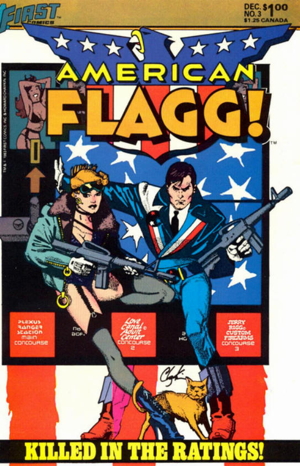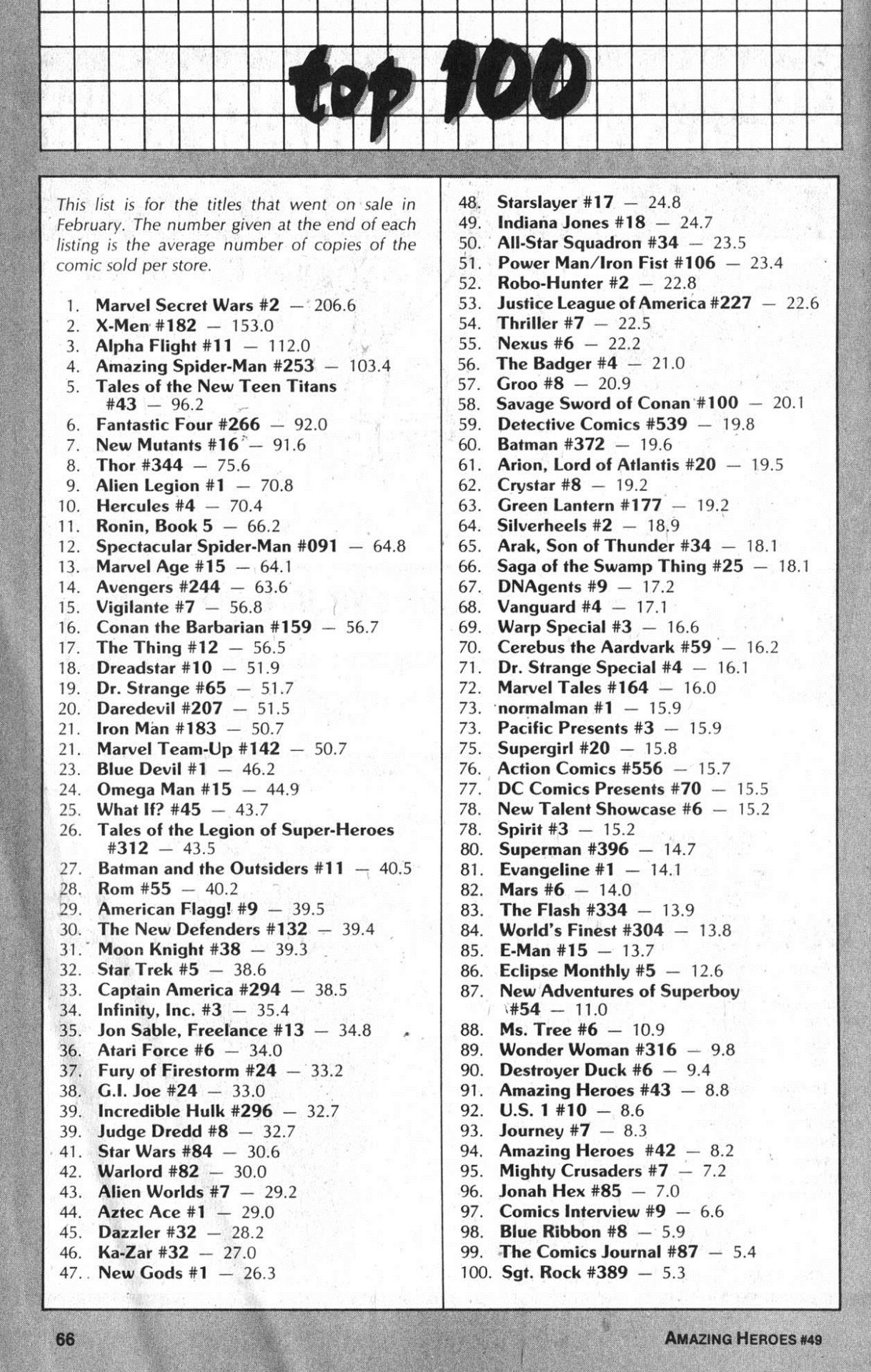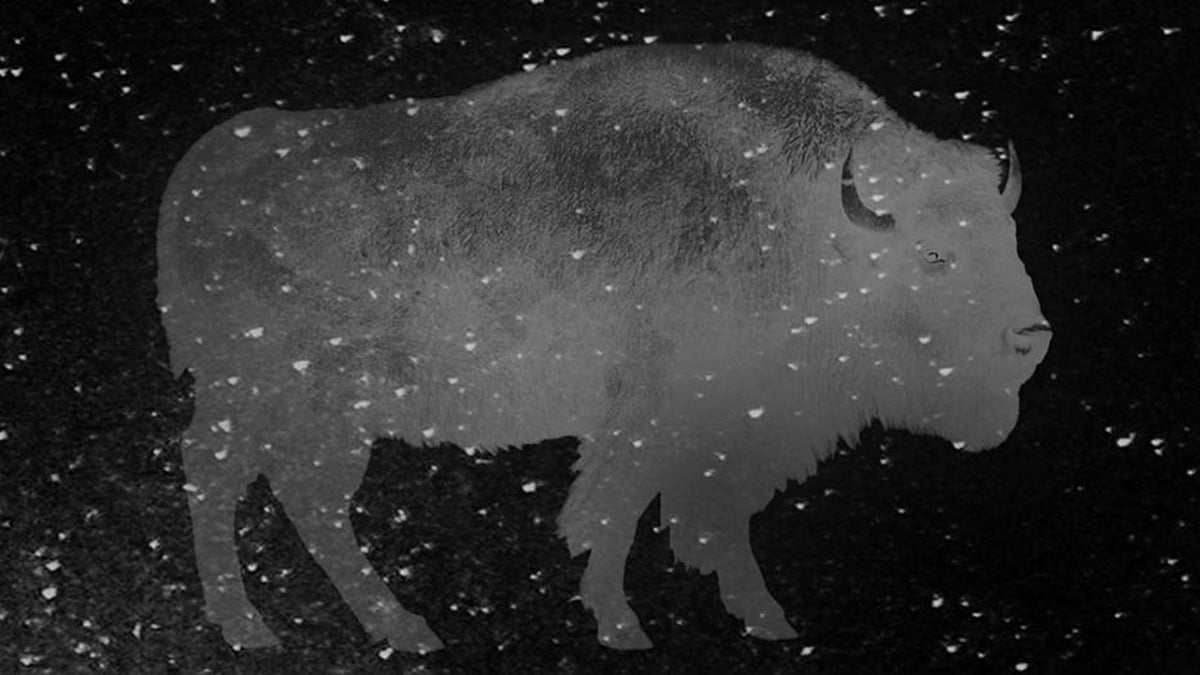Over the holiday I spotted something pretty eye-popping on Tumblr—this comics sales chart from Amazing Heroes #49, published in 1984 and posted by Sam Humphries.
Your jaw will drop in amazement to see a world where American Flagg!, a daring SF comic by Howard Chaykin outsold Captain America, and Groo outsold Batman, Detective and Green Lantern.
It’s also a fairly dizzying array of genres, with Conan, Alien Legion, Dreadstar, Nexus, Aztec Ace and Evangeline in the top 100.
What the hell kind of bizarro world was this? Well as Comichron sales historian John Jackson Miller tweeted, it was Capital Distribution’s world:
@Comixace This was picked up from Capital's Internal Correspondence; these are order index numbers with each. Also note…
— John Jackson Miller (@jjmfaraway) November 29, 2014
@Comixace …that since Capital was getting worse terms from DC in its early days, its indie sales were more relative to it.
— John Jackson Miller (@jjmfaraway) November 29, 2014
…thus it’s not indicative of the entire comics sales world. MIller’s own archives only go back to the 90s, so we don’t have the exact info to compare with Diamond.
It’s still a pretty eye opening chart however. Indie comics routinely sold 50,000 copies, even ones forgotten today, and while the 80s may not have had the artistic wonderland and individual expression we have today, superheroes had far less of a stranglehold than they would have in the 90s. Of course that stranglehold was partly the result of the demise of Capital City Distribution, which had a more indie-centric focus. If Capital hadn’t been done in by the distribution wars of the 90s—leading to its acquisition by Diamond in 1996—we might have had a very different development of comics.
That said, I like where we are now.










While we’re on the topic of comics in the 1980s, here is a forgotten factoid: Marvel and DC single issues were significantly cheaper than the vast majority of indie comics. So much so that it was accepted as fact that pricepoint was one of the key barriers to sales for independent publishers.
Now look at 2014: the cover prices for Marvel and DC are on a par with (or in some cases higher than) many independent publishers’ single issues.
Well, I take it back. At a glance I thought it was the Cap City chart — but looking now at the Feb. 1984 Internal Correspondence, it’s different in several regards — and does not yet have the Order Index Numbers listed. So this would be AH’s own research, which I seem to recall editor Dave Olbrich saying was generated from retailer reports. (But I could be remembering that wrong…)
But Capital City’s Top 300 does share many things in common, and has the aforementioned Marvel/DC split. The AH list contains things not on the Capital list, like RONIN — there was never a perfect matchup between the distributor charts and release date-based lists in those days. I scanned the Cap City chart here: https://twitter.com/comichron/status/539496344151674880
What’s most amusing about this chart is the reminder of how, before Miller and Moore made their contributions to DC’s canon, Marvel was just BUTCHERING their main competition, DC. Only one regular DC title in the Top 20, and Miller’s Ronin limited series.
Okay, I have located Dave’s note to me about them, from many years ago: “We had a group of retailers who would regularly send us information about their sales … back in the stone age when there was nearly no information at all.” I had forgotten about that — apologies.
It is then in the same ballpark, data-wise, with the Market Beat numbers we ran from our retail surveys for years in COMICS & GAMES RETAILER, starting in 1994. I spent umpteen hours on them and the results were pretty good in the years when the response was heavy — we had close to a hundred shops reporting at the peak. But since we weren’t getting the same shops every month and they weren’t reporting on every title, it wasn’t as reliable as it might have been. It’s one more resource which may or may not wind up on Comichron as I get time…
” … and while the 80s may not have had the artistic wonderland and individual expression we have today …”
I found this to be the most ridiculous claim I’ve read in a while. You look at the sheer diversity of books on that list and it’s clear how much of a wasteland today’s market is. .
On the diversity score, I would note that you’re looking at almost every comic book that came out in February 1984 on that list above. In terms of number of releases, that period — right when the other newsstand-focused publishers are dying and just before the black-and-white boom — saw incredibly light release slates from the major publishers. It’s easy for independent books to make the Top 100 when there’s only 130 or so comics coming out overall, and when almost all the main Marvel titles are accounted for by the time you hit 50th place.
By contrast, February 2014 — a light release month for these days — had 443 different new comics coming out, less than 35% of them from Marvel and DC. No, the Top 100 doesn’t look as diverse — Marvel and DC took 88 out of the Top 100 slots — but that’s because they’re publishing so much more. Combined, though, their market shares are much less than they were then, so it’s not just that offerings are spread across more publishers now: sales are, too.
Blake — You’re missing Titans and Vigilante. 3 out of 20 is better. A bit.
-B
As a fun data point, I have from Dave Sim that CEREBUS #59 (70th on the above list) had a total print run of 20,000 copies. And yet Cerebus is up there outselling SUPERMAN #396 on the Amazing Heroes list in a year when postal statements put Superman at around 110-115,000 copies a month, newsstand included.
The reason is that the Direct Market — or sample groups of it like the AH reporting stores — simply wasn’t yet reflective of the overall picture for the mainstream publishers and books that were still mainly newsstand plays. The earliest Superman issue for which I have Capital City’s internal data shows the distributor sold 4,600 copies of #407 — which was still only about 5% of the overall sales, including newsstand. At those levels, yeah, we can believe that Cerebus was competitive with Superman — just only in the comic shops, and only until the major publishers turned more of their attention toward the Direct Market.
Looking at that chart… Supergirl #20 outsold both Action Comics #556 AND Superman #396.
Whoa!
It was a Titans/JLA crossover, which I’m guessing gave it a boost on AH’s sales-by-retailers list.
(Not that Supergirl couldn’t have been more popular than those other books — but DC did cancel it three months later, even though a movie was due out that summer.)
“Average number of copies per store”.
Okay… it’s weighted a little, since these are stores which were able to report their order numbers, and thus a bit more organized than some. (In 1984, cash registers were high tech.)
I started collecting a few months after this list (Amazing Spider-Man #254).
Note that Ka-Zar, Moon Knight, and Micronauts were Direct Market-only titles.
Knowing the general number of stores now… how does the Top 300 compare, when averaged by store?
Well, you’d figure today a 100,000 copy seller would be doing between 35 and 40 copies per store. But it is greatly skewed because the median store is quite a bit different from the average store. I would think it would be even more the case in 1984. We know the number of copies a lot of these titles sold to the Direct Market, and these reported averages are so high that the only way they work is if there were a lot of stores ordering very small quantities. And that was probably the case: for every store on Amazing Heroes’ radar screen, there were several shops just dabbling or just getting started.
If that’s a “fairly dizzying array of genres” I’m a fairly bewildered pseudo-dragon with a +2 sword.
“You look at the sheer diversity of books on that list and it’s clear how much of a wasteland today’s market is.”
Huh? What do you consider “today’s market”? If you just look at comics shops, or the top-selling titles, you don’t see much but superheroes, but digital delivery adds a whole lotta diversity, and the web blows it away.
DC being outsold this badly would explain why Marvel was approached back then to take over their line.
THE COMIC READER ran similar retailer survey charts from 1979-1981, I posted a few and looked at some specifics. The direct market started off pretty hardcore Marvel-centric, on the earliest charts you go through the entire Marvel super-hero line before you get the first DC super-hero book.
The thing to remember, too, is that neither Capital nor Diamond were the only distributors to the direct market at this time. There were a dozen or more regional distributors, including Seagate, Bud Plant, Styx and Friendly Frank’s, that were coming into existence and merging and whatnot across the entire decade. Comcis & Comix was so large a chain at certain points that it could have been considered its own distributorship. At least three publishers came out of these distributors — Pacific Comics and Blackthorne were both offshoots of Pacific and while First wasn’t created by Capital, it certainly did benefit enough from Capital’s eponymous imprint imploding and gaining them Nexus, Badger and, arguably, Whisper — that even Capital’s 4,600 copies of Superman #407 has to be taken with a grain of salt when there were other distributors ordering similarly small numbers of any given title, Marvel, DC or Indie.
“You look at the sheer diversity of books on that list and it’s clear how much of a wasteland today’s market is.”
Ugh. Not only were comics on the whole more diverse in the 80s than today, superhero comics were more diverse than today’s superhero comics as far as art style, storylines, etc etc. The readership was a lot more diverse too.
…Alpha Flight? Seriously?
About 20 years ago The Comics Buyer’s Guide reported that whenever comics publisher raised prices, sales declined across the board and that decline has continued. $4.00 for a comic book just isn’t a competitive price and sales prove that.
The 1980s was a wonderful time for comics diversity — especially that early period when First Comics was publishing Jon Sable, Freelance and American Flagg.
Unit sales have been up since 2010, so the market appears to have been more willing to absorb higher prices over the last few years. The problem really is that publishers seem married to large gaps between price points, and it takes some time before the market makes the jump: $3.99 was a bridge too far in 2009, but is more acceptable today. Archie, which sells in a marketplace much more sensitive to price, has shown more of a willingness to try intermediate steps between one dollar and the next.
And Alpha Flight was a huge deal in that era, at least in its first year. The same month it ordered 4,600 Superman #407s, Capital City ordered 34,000 Alpha Flight #22s.
Folks who are surprised by the position of Alpha Flight on the chart above don’t appreciate the extent of Byrne’s “artist superstar” status in the 1980’s.
Has anyone done an aggregate on unit sales with the other dist’s? I know that Marvel policy in the 80s was to cancel any book that sold under 100K so this is obviously incomplete.
I’ve got a lot of Marvel’s internal documentation from the 1980s about what went to distributors, as well as all the postal reports and some of the audit bureau information. The Direct Market in the mid-1980s was still less than half Marvel’s sales on most titles (but growing by leaps and bounds); on that Alpha Flight #22, for example, overall sales would have been nearer 300k.
We used to chuckle at these “stats”. Our undergrounds sold only in a few comic shops and lots of head shops. In 1980 we were selling to 30 different distributors. They were a great bunch, but became the Donor party of popular culture. American Flagg was a superb series and its narrative thread is the basis of dozens of tv series and movies, but no credit to Howard Chaykin. Capital City was itself created from previous distributors such as W.I.N.D. Wisconsin Independent News Distributors. It is down to just Diamond and Last Gasp now.
Lot of talk about diversity in the 80s. I agree, there was. Even within DC, there was a lot. Sadly, the 80s was also the end of DC’s diversity. Basically, every war, western, horror and humor comic from DC bit the dust during this decade (DC’s romance line vanished in the 70s). Their attempts to bring back the war genre (G.I. Combat and Men of War) both failed miserably (I don’t consider Star Spangled War Stories with G.I.Zombie a war comic).
I know I’ll be hammered by other posters with, “Well, what about Vertigo?”. Well, I’m talking about the DC imprint proper as opposed to the Vertigo imprint.
Rob e: vertigo wasn’t founded until 1993. Let them send forth their hammers. :)
There are a lot of fantastic comics on that list, from a number of publishers! Nearly everything that First Comics was putting out in those years was pure gold. :)
Bob:
No hammer needed. I know Vertigo didn’t start until 1993. I just pointed out Vertigo just in case someone tried to say that DC still covered a lot of genres after the 80s. Yes, they did with Vertigo, but I my original post was referring the “DC Universe”, not other imprints owned by DC.
Just between you and me, I personally liked a lot of what Vertigo had to offer.
“It’s also a fairly dizzying array of genres, with Conan, Alien Legion, Dreadstar, Nexus, Aztec Ace and Evangeline in the top 100.”
This is key. On a personal level lately I’ve been thinking about how weird it is that these days we pay SO MUCH attention to successful titles (like Saga or Walking Dead) that even pull one step away from the normal superhero genre, but back in the ’80s and ’90s we seemed to see more successful titles of other genres and subgenres.
We tend to overemphasize things today and make it seem as if ONLY NOW do we have even the slightest degree of diversity, when that’s just not true. Are we more diverse now than ever? Very arguably, yes. Then again, when you had indie titles like Bone, Cerebus, TMNT, Sandman and even Spawn selling a ton of copies… the late ’80s and early ’90s sure had quite a number of very successful non-standard titles to boast of.
To give another example, I’m fairly glad that the most recent Ms. Marvel has found success. On the other hand, it’s like we’re counting on our fingers whenever female superhero titles last more than 10 issues. We act like it’s something new. But, uh, the last Ms. Marvel series lasted 50 issues. She-Hulk has had a couple quite lengthy runs. Silver Sable had a long run. We’re on the verge of celebrating Spider-Gwen… while forgetting that Spider-Girl was published for like a decade. Spider-Woman and Ms. Marvel were both successful titles in the ’70s. I do think that obviously certain sorts of progress are being made in the 2010s… but I still think that at times we’ve been reduced to counting victories on our fingers, one by one, as if they were more unprecedented on every level than they actually are.
But…
“…while the 80s may not have had the artistic wonderland and individual expression we have today”
I dunno about that one. The indie boom of the early ’80s, combined with the rise of writers like Moore and Miller, definitely led to a TON of very high quality auteur projects. Is there more individuality now, in the era of webcomics and 500 different comic titles a month in Previews? I think it depends by what you mean by “individuality”. Call me a cynic but I find a LOT of indie titles today to basically have the same brand of snarky “hipster” voice behind them. Meanwhile Cerebus and TMNT were as different as night and day.
“But, uh, the last Ms. Marvel series lasted 50 issues. She-Hulk has had a couple quite lengthy runs.”
Spider-Woman was also a 50 issue run, originally.
Comments are closed.